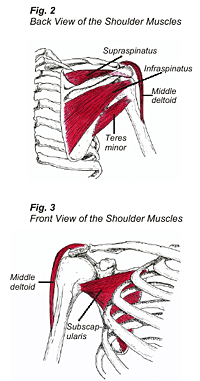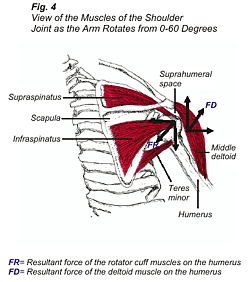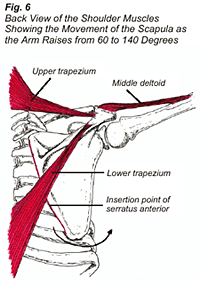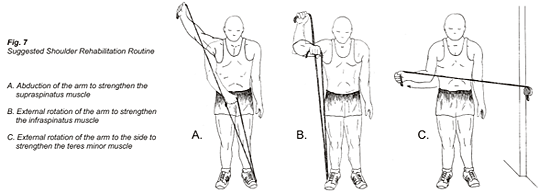 Impingement syndrome is a shoulder disorder characterized by a dull aching on the front and outside of the upper part of the arm that sometimes radiates to the elbow. Sleeping on the injured shoulder is painful, and when raising the arm by the side, the pain can be sharp and stabbing in nature. Impingement syndrome is common in individuals participating in sports such as volleyball, swimming, basketball, tennis, and baseball, and in occupations requiring arm movements above the shoulder or head. These activities may cause a repetitive strain injury to the muscles surrounding the shoulder, leading to faulty joint motion and compression on tendons in the shoulder, resulting in impingement syndrome. An explanation of the biomechanics of the shoulder will make it easier to understand the causes of impingement syndrome and how to treat and prevent it.
Impingement syndrome is a shoulder disorder characterized by a dull aching on the front and outside of the upper part of the arm that sometimes radiates to the elbow. Sleeping on the injured shoulder is painful, and when raising the arm by the side, the pain can be sharp and stabbing in nature. Impingement syndrome is common in individuals participating in sports such as volleyball, swimming, basketball, tennis, and baseball, and in occupations requiring arm movements above the shoulder or head. These activities may cause a repetitive strain injury to the muscles surrounding the shoulder, leading to faulty joint motion and compression on tendons in the shoulder, resulting in impingement syndrome. An explanation of the biomechanics of the shoulder will make it easier to understand the causes of impingement syndrome and how to treat and prevent it.
 The glenohumeral joint, or shoulder joint, is a ball-and-socket articulation where the round head of the humerus fits into the concave glenoid fossa of the scapula (Fig. 1).
The glenohumeral joint, or shoulder joint, is a ball-and-socket articulation where the round head of the humerus fits into the concave glenoid fossa of the scapula (Fig. 1).
The stability of the shoulder joint is maintained by four muscles: the supraspinatus, infraspinatus, teres minor, and subscapularis muscles, whose conjoined tendons comprise the rotator cuff (Fig. 2 & 3). The middle deltoid muscle travels from the acromium process of the scapula and is attached to the humerus, acting as a lever when the arm raises up by the side from zero to sixty degrees (the deltoid muscle also pulls the humeral head superiorly and out of the glenoid fossa). To keep this motion in check, three of the four rotator cuff muscles exert a downward pull on the humeral head, while the fourth muscle exerts an inward pull on the humeral head, pulling it toward the glenoid fossa (Fig. 4).
There is a “tunnel” in the shoulder joint, the suprahumeral space, which separates the bone at the top of the shoulder from the arm bone. (Fig. 1, green border). The supraspinatus and long head of the bicep tendons pass through this suprahumeral space, and are subject to pressure from the nearby bones: the acromium process and the humeral head.
Weakness of one or more of the rotator cuff muscles may lead to abnormal upward movement of the humeral head, decreasing the suprahumeral space and putting pressure on the tendons, causing pain (compare Fig. 5A, showing a normal suprahumeral space, to Fig. 5B, showing a decreased suprahumeral space).
 Normally, when the arm raises from 60 to 140 degrees (Fig. 6), the upper trapezium, lower trapezium, and serratus anterior muscles move the scapula and the attached acromium process upwards, maintaining the suprahumeral space. improper function of the rotator muscles or the muscles surrounding the scapula can lead to a decreased supra- humeral space when moving the arm away from the side of the body, increasing the of injury to the supraspinatus and long head of the bicep tendons and eventually to the development of impingement syndrome. This syndrome, while often caused by acute or overuse injury, may also be due to degenerative changes, in which case referral to a surgeon would be recommended.
Normally, when the arm raises from 60 to 140 degrees (Fig. 6), the upper trapezium, lower trapezium, and serratus anterior muscles move the scapula and the attached acromium process upwards, maintaining the suprahumeral space. improper function of the rotator muscles or the muscles surrounding the scapula can lead to a decreased supra- humeral space when moving the arm away from the side of the body, increasing the of injury to the supraspinatus and long head of the bicep tendons and eventually to the development of impingement syndrome. This syndrome, while often caused by acute or overuse injury, may also be due to degenerative changes, in which case referral to a surgeon would be recommended.


Conservative therapy at Dr. Dubin’s office to treat impingement syndrome would consist of:
- Adjustments to the scapulothoracic joint, glenohumeral joint, and cervical spine to free up joint motion
- Electric muscle stimulation and ultrasound combotherapy to restore normal muscle tone, break up adhesions, and decrease pain
- Specific muscle work to the rotator cuff and surrounding musculature of the scapula and humerus to free up soft tissue motion and allow for return of strength and function
- Integration of a shoulder rehabilitation routine to increase strength of the shoulder musculature, allowing for proper function and the prevention of future shoulder injuries (Fig. 7) (Such a workout routine should not be initiated without proper instructions from a doctor and the supervision of a strength conditioning specialist.)
- Instruction to ice the shoulder at home for a time period of 20 minutes on, 1 hour off, as frequently as possible to decrease inflammation.


